Roger Keith "Syd" Barret (6 January 1946 - 7 July 2006)
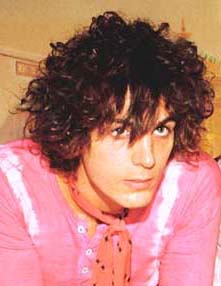
The Early Years
Roger Keith Barrett was born in Glisson Road, Cambridge, to Winifred and Arthur Barrett, on January 6th, 1946.
From an early age, he displayed a musical and artistic nature, and played the ukulele, the banjo, and piano, he won a prize for a piano duet at the tender age of seven. He then took up the guitar.
As he built on his guitar skills, in his exploration of music, in in may different styles. He used to go,
to the Riverside Jazz Club, where a drummer by the name of "Sid Barrett" used to play. It was during one of his visits the young Roger Barrett, got the name "Syd" spelt with a "Y" a name which stuck.
With his growing musical talents, he played in various bands in Cambridge and London - bands such as Geoff Mott and The Mottoes, Those Without, The Hollerin' Blues, The Spectrum Five, Leonard's Lodgers,.
The Start Of Pink Floyd (1964-1968)
Starting in 1964, the band that would become Pink Floyd underwent various changes. Bob close was an early member of pink floyd and he left not long after they recorded a demo of Lucy leave, which has never been officially released.
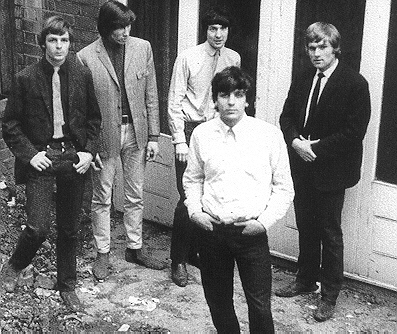
left to right Richard Wright,Roger Waters, Nick Mason, Bob Close,
Front Syd Barrett
They went through a few name changes such as, "The Abdabs", "The Screaming Abdabs", "Sigma 6" and "The Meggadeaths".
In 1965, going under the name of "The Tea Set", they were doing a gig one night and found out that a band called "The Tea Set" were already on the bill.
Syd then came up with a new name for the band, "The Pink Floyd Sound" which later became just Pink Floyd. he came up with the name "Pink Floyd" by joining the first names of two not well known blues musicians "Pink Anderson" and "Floyd Council"
In 1966 a new underground scene was emerging in London, and the early floyd were performing at fringe events and small clubs.
"The Pink Floyd Sound" began by playing cover versions of American R&B songs in much the same vein as contemporaries The Rolling Stones, The Yardbirds and The Kinks. they had carved out their own style of improvised rock and roll, which drew as much from improvised jazz as it did from British pop-rock, such as that championed by The Beatles.
Also in that year, a new concert venue, "The UFO Club", opened in London and quickly became a haven for British psychedelic music. They used to perform at the UFO club (In which they later became a house band) they're first manager seen them doing a feakout gig at the marquee. But they were getting more popular and they were looking for a manager by this time.
Andrew King and Peter Jenner took management of the band near the end of 1966, and they befriended a guy call Joe Boyd
Joe Boyd ran a place called The UFO club. he was an American music producer, and was looking for new bands to sign.
He recalled it was about the summer of 66 that peter and Andrews told him of a band he wanted him to hear and gave him a demo tape. Joe was very impressed and though they were great.
In January 1967 Boyd produced a recording session for the group at the "Sound Techniques in Chelsea," which resulted in a "Arnold Layne" demo Jenner and King then took the "Arnold Layne" Demo, to Recording giants EMI. after hearing it EMI Signed Pink Floyd to they're record label.
This was their first recording contract.
Pink Floyd Sign To EMI Records
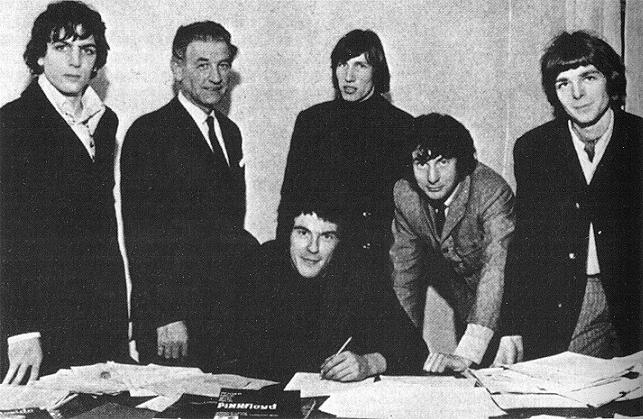
Arnold Layne It was a song about a guy with an underwear fetish, who was pinching underwear off washing lines in the Cambridge area!
Barrett coined the phrase "moonshine washing line, they suit him fine"
Which resulted in the single being banned by Radio London, for being smutty, in it's reference to cross dressing.
The police were involved and the underwear fetish thief, gave up his nighttime raids.
He was never caught and is possibly still going to this day
"Arnold Layne" reached number 20 in the UK Singles chart, by this time their first album was finished too
Arnold Layne
Piper At The Gates Of Dawn

The band's first album, Piper At The Gates Of Dawn, was also recorded during this period, as were Syd's contributions (Jugband Blues) to the second album (A Saucerful Of Secrets)
The album title "Piper At The Gates Of Dawn" was taken from a reference in a chapter of the children's story The Wind in the Willows. their first three singles, '"Arnold Layne" "See Emily Play" and "Apples and Oranges" were all written by Barrett, who also was the song writing genius behind the critically acclaimed 1967 debut album,The Piper at the Gates of Dawn, Syd wrote eight of the songs and co-wrote another two.
The Piper at the Gates of Dawn was recorded between January and July 1967 in Studio 2 at Abbey Road Studios, and produced by former Beatles engineer Norman Smith.This was during same time at Abbey Road that The Beatles were recording Sgt. Pepper's Lonely Hearts Club Band in Studio 1 and the Pretty Things were recording S.F. Sorrow. When The Piper at the Gates of Dawn was released in August of that year it became a smash hit in the UK, hitting No.6 on the British album charts
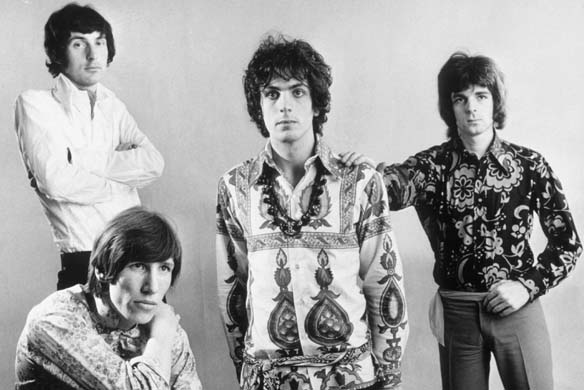
(left to right: Roger Waters, (Nick Mason back) Syd Barrett, Richard Wright)
However, as the band began to become well known and were getting more, and more, popular, the mounting pressures on Barrett from the record company, and the demands of success are thought to have contributed to psychological problems, as well as reports of him using psychedelic drugs mainly LSD.
The Floyd toured extensively between 1965 - 1967 in a punishing schedule which saw them even play more than one country some evenings! Through late 1967 and early 1968 Barrett's behavior became increasingly erratic and unpredictable, partly as a consequence of his reported heavy use of psychedelic drugs. Many report having seen him on stage with the group, strumming on one chord through the entire concert, not singing, or not playing at all.
It was also rumored that "part of the myth of Syd Barrett relates how he was interested in joining a sect of mid-Eastern mystics who practiced astral travel to planets-also practiced in India - but the group felt he was too immature to handle it. He resorted to a diet of LSD in order to produce the effect..."
At a show at The Fillmore West in San Francisco, during a performance of "Interstellar Overdrive", Barrett slowly detained his guitar. The audience seemed to enjoy such antics, unaware of the rest of the band's concern. Before a performance in late 1967, Barrett reportedly crushed Mandrax tranquillizer tablets into an an entire tube of Brylcreem, which he then emptied onto his head, then walked out on stage!
Under the heat of the stage lights, the brylcreem melted down his face under the heat of the stage lighting, apparently looking something similar to "a guttered candle".
During their disastrous abridged tour of the United States guitarist David O List from The Nice was called in to substitute for Barrett on several occasions when he was unable to perform or failed to appear. On their return to the UK David Gilmour (a school friend of Barrett's) was asked to join the band as a second guitarist to cover for Barrett, whose erratic behavior prevented him from performing.
A Saucerful of Secrets

A Saucerful of Secrets is the second studio album by Pink Floyd. It was recorded at EMI's Abbey Road Studios at various dates from August 1967 to April 1968. Due to Syd Barrett's declining mental state, this was to be the last Pink Floyd album he would work on.
During its difficult recording sessions, Barrett became increasingly unstable and in January 1968 David Gilmour was brought in to Pink Floyd for a handful of shows & finish the album. David played and sang while Barrett wandered around on stage, occasionally deigning to join in playing. As a result, A Saucerful of Secrets is the only non-compilation Pink Floyd album on which all five band members appear, with Gilmour appearing on four songs ("Let There Be More Light", "Corporal Clegg", "A Saucerful of Secrets", and "See-Saw") and Barrett on three ("Remember a Day", " "Set the Controls for the Heart of the Sun" and "Jugband Blues").

Front Left to right: Nick Mason, Roger Waters, Richard Wright.
Back left to right: David Gilmour & Syd Barrett.
The promotional video for the song features Barrett (shown with an acoustic guitar for the first time) and the group miming to the song in a more conventional stage setting, with psychedelic projections in the background. The original audio to the promo is lost, and most versions use the BBC recording from late 1967, consequently causing sync issues most evident as Syd sings the opening verse. Roger Waters and Richard Wright switch to tuba and trombone respectively in the brass-driven instrumental break.
Barrett wanted a Salvation Army band to play on the track. They were brought in, but when he stated that he wanted them to simply "play whatever they want" regardless of the rest of the group, Norman Smith insisted on recorded parts. Eventually both versions were recorded and used.
Because of Barrett's increasingly erratic behavior, which reduced his commitment to both songwriting and recording, as well as song's distinctive three-tiered structure (all three parts are in separate keys and in different time) some listeners believed that "Jugband Blues" was more than likely a mash-up of three of four separate Barrett demos from various points that the rest of the band spliced together; presumably to create the impression that "Jugband" was a singular, stand-alone piece. But this has proven not to be the case, and that "Jugband Blues" was recorded how Barrett composed it.
The song is viewed by many fans as a sad farewell piece by Barrett who, by the beginning of the recording sessions for Saucerful of Secrets, was already shrinking into a delirious state of mind, exacerbated by his feelings of alienation from the rest of the band, as can be gleaned from the painfully specific lyrics in the song
Jugband Blues
"Jugband Blues" Lyrics
It's awfully considerate of you to think of me here
And I'm much obliged to you for making it clear
That I'm not here.
And I never knew the moon could be so big
And I never knew the moon could be so blue
And I'm grateful that you threw away my old shoes
And brought me here instead dressed in red
And I'm wondering who could be writing this song.
I don't care if the sun don't shine
And I don't care if nothing is mine
And I don't care if I'm nervous with you
I'll do my loving in the winter.
And the sea isn't green
And I love the queen
And what exactly is a dream
And what exactly is a joke.
Although it has been argued that the common interpretation of the lyrics as reflecting Barrett's dementia owes more to Barrett's popular image more than fact, and that they could be read as a criticism of the other band members for forcing him out
"Jugband Blues" is the second song from Saucerful to appear on the compilation album Echoes: The Best of Pink Floyd (the first being "Set the Controls for the Heart of the Sun"). It is ordered near the end of the second disc, immediately following "Wish You Were Here", a song written by the rest of the band in 1975 in tribute to Barrett. Actually, the song didn`t really fit in the structure of the band`s second record, but they`d always planned to include at least one of Barrett`s contributions from late 1967 as they always knew, especially after his departure, how much they owed to him. Being the closing track then, it really seemed to work best as Barrett`s farewell for the Floyd.
As well as "Jugband Blues", the album was to include "Vegetable Man," another Syd Barrett song.
Peter Jenner called it "a song Syd wrote describing himself as he sat at Jenner's home. He had to go and record and, because a song was needed, he just wrote a description of what he was wearing at the time...Many cite it as a document of Syd's monumental breakdown as a recording artist and as a person. Jenner wanted the song to be released on the Syd Barrett rarities album Opel (1988), but the band blocked its inclusion.
However, the band believed "Vegetable Man", with its autobiographical lyrics, was unsuitable for inclusion and so it was left off the album. The song was to appear on a single as the b-side to another unreleased track, "Scream Thy Last Scream". Two additional Syd Barrett songs "In The Beechwoods" and "No Title" were also recorded early in the sessions for the album.
Keyboardist Richard Wright sings lead or backing vocals on four of the album's seven songs, making this the only Pink Floyd album where Wright's vocal contributions out number those of the rest of the band. This was also the only album to contain lead vocals by all five Pink Floyd members (Mason sings lead parts on "Corporal Clegg").
The unable to perform live, the band's initial plan was to keep him in the group as a non-touring member.
Barrett had, up until then, written the overwhelming bulk of their material -- but this soon proved to be impractical.
But due to his (Apparent) excessive lsd taking, erratic, and unpredictable behavior Syd was was eventually left out the band.
Richard wright once said: He was living with Syd at the time and would say something like "I'm just going out to get cigarettes Syd" and would go do gigs without telling him, leaving Rick feeling awful.
The other band members soon tired of Barrett's antics and, in January 1968, on the way to a show at Southampton
Shall we pick Syd Up?............ to which another voice said no, lets just leave it.
The Solo Years
By the start of start of 1968, Syd pursued a solo career.
Two solo albums were to follow, taken from various sessions recorded between 1969 - 1971.
the first album to come out of this very fragile period "The Madcap Laughs" (Recorded at Abbey Road 28 May 1968 - 5 August 1969)
& the second the self titled "Barrett" Album.
Floyd-turned-Syd Barrett manager Peter Jenner in May 1968. Although the sessions were brief, and they produced some fine material, the project was abandoned for almost a year while Barrett spent much of the year as a recluse.
The Madcap Laughs

In April 1969, Malcolm Jones took over the project and Barrett began working on newer material, while reworking the 1968 recordings. Session musicians, namely, members of The Soft Machine, as well as Humble Pie drummer Jerry Shirley were also called in to augment Barrett's songs. It is still a mystery why Jones abandoned production responsibilities, at the end of May, so soon after having assumed them. Jones' recollections of the sessions are that he and Barrett got on well together and had in fact completed half of the album before the new producers took over. Roger Waters and David Gilmour were in the process of completing Pink Floyd's ambitious Ummagumma album when they got involved with The Madcap Laughs that July and helped Barrett finish his album, "in a two-day sprint" according to Rick Sanders, author of Pink Floyd (Futura Publications, 1976).
The album featured a rather unorthodox recording process, in which Syd would provide a backing track of his own singing accompanied by acoustic guitar, over which the session musicians would overdub the rest of the arrangement. However, Syd's playing and singing were highly erratic and unpredictable-he skipped or added beats and bars seemingly at random, or otherwise he would strum on a single chord for a long time before unexpectedly reverting back to the main portion of the song. This was all much to the frustration of the session musicians; a close listen to several tracks [in particular "No Good Trying" and "Love You"] will reveal the backing band hovering uncertainly here, or being caught off-guard by a chord change there (during an interview, Robert Wyatt recounted that musicians would ask "What key is that in, Syd?" and Barrett would reply "Yeah", or "That's funny"). Syd would not allow the musicians to rehearse or re-record their overdubs, insisting that they sounded fine. After several months of intermittent recording, the album was finally deemed complete.
"Octopus" was released as a single in November 1969 and the album itself followed in January 1970. It reached #40 in the UK at the time and was fairly well-reviewed.
Barrett

(The various fly's on the Album cover were all hand painted by Barrett himself)
Barrett was the second and final studio album of new material released by Syd Barrett.
In February 1970, shortly after releasing his first album, (The Madcap Laughs), Barrett appeared on John Peel's Top Gear radio show where he presented only one song from the newly released album. Two days later, he began working on his second album in the Abbey Road Studios, this time with Pink Floyd members David Gilmour and Richard Wright as producers and musicians.
The main aim for the Barrett sessions was to give Syd the structure and focus many felt was missing during the long and unwieldy sessions for The Madcap Laughs. Thus, the sessions were more efficiently run - with much unreleased material recorded - and the album was finished in far less time than it took to complete The Madcap Laughs.
Barrett was released in November 1970 to less interest than had greeted The Madcap Laughs earlier in the year, and as a result, failed to chart.Syd done a few gigs in a band under the name of stars in 1972, and some abortive recording sessions in 1974, but this wasn't very successful.
Apparently in his final gig, he seemed like he wasn't interested, and diffident want to be there. He wasn't making much effort, and seemed unthusiastic. the drummer at the time Gerry Shirly remembered: they were on stage performing a song and Syd just took his guitar off, put it down and walked out! leaving the other band members still going, they quickly bring performance to an end and walked off stage themselves
Cambridge
Barrett promptly headed back to his hometown of Cambridge and Syd Barrett retired from the public eye, & left his music career behind for good, choosing to live out the remainder of his life in his mother's house, even after her death in 1991.
Barrett still received royalties from his work with Pink Floyd from each compilation and some of the live albums and singles that had featured his songs; Gilmour has commented that he himself made sure the money got to syd all right"
Although Barrett had not appeared or spoken in public since the mid-1970s, time did little to diminish interest in his life and work; reporters and fans still traveled to Cambridge to seek him out, despite his attempts to live a quiet life. Many photos of Barrett being annoyed by paparazzi when walking or biking, from the 1980s until his death in 2006, had been published in various media.
Apparently, Barrett was not happy being reminded about his past as a musician and the other members of Pink Floyd had no direct contact with him. However, he did go to his sister's house in November 2001 to watch the BBC Omnibus documentary made about him – reportedly he found some of it "too noisy", enjoyed seeing Mike Leonard (of Leonard's Lodgers) again (whom he called his 'teacher'), and enjoyed hearing "See Emily Play" again.
Barrett, who had reverted to using his original name of Roger, and had returned to his original art-form of painting, creating large abstract canvases, he reportedly wrote a book about the history of art, for his own amusement (with no intention of publishing). He was also said to have been an avid gardener. His main point of contact with the outside world was his sister, Rosemary, who lived nearby. While reclusive, it was his physical health that prompted most concern, being afflicted with stomach ulcers and type 2 diabetes
After battling diabetes for several years, Syd Barret sadly passed away (peacefully) at his home in Cambridge due to complications with diabetes on Friday 7 July 2006, he was 60 years old. The cause of death was pancreatic cancer, but this was usually reported as "complications from diabetes".
The occupation on his death certificate was given as "retired musician"
He was cremated, with his ashes given to a family member or friend.
He will live on in the hearts & minds of his friends, family, & many fans across the world.
Remember When You Were Young
A Young Syd playing his acoustic guitar in Cambridge
The Wish You Were Here Sessions
In 1975 during the recording sessions for Wish You Were Here. He attended the Abbey Road session, it was normal to have people hanging out at recording sessions there was always people or strangers coming in unannounced.
One day one of the band members said there's a strange guy out there acting oddly, do you know who he is?
Someone else said i thought he was with you or one of the others?
Eventually, they realized who he was, it was Syd!
He had become quite overweight, had shaved off all of his hair (including his eyebrows), he was barley recognizable.
Barrett's behavior at the session was erratic, and he spent part of the session jumping up and down while brushing his teeth.Roger Waters was so distressed by the change (and strange behavior) in his old friend, that he was brought to tears.he watched the band record "Shine On You Crazy Diamond" - a song that happened to be about Barrett.
Roger finally managed to ask him what he thought of the song, and he simply said he did not like it, and walked out of the studio.
This would be the last time any member of Pink Floyd would ever see him again
The Syd Barrett & Pink Floyd Story
Part 1
Part 2
Part 3
Part 4
Part 5

click here to watch the video


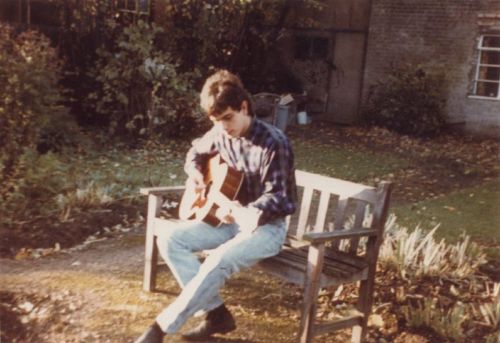




No comments:
Post a Comment
Note: only a member of this blog may post a comment.